April 2023: Virtual Apprenticeships: How Do They Work?
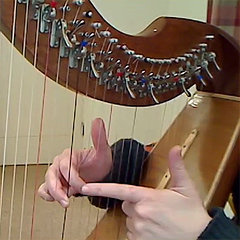
In our Spotlight series, we take a closer look into the kaleidoscope of traditional arts in Central Pennsylvania and the work of artists featured in our Folk Artists Gallery. This article spotlights two traditional arts apprenticeships that use distance learning.
By SFMS folklorist Amy Skillman
April marks the application deadline for the Apprenticeships in Traditional Arts grant program of the Pennsylvania Council on the Arts (PCA). As a Folk Arts Partner with the PCA, one of SFMS’s roles is to support local artists in their application process. Last year we helped three artists with their applications and all three were funded: not a bad track record. I have had the pleasure of visiting two of the three partnerships to talk with them about their work.
Apprenticeships are intended to pass on the artistic skills, the history, and the cultural knowledge that makes the art so meaningful to the practitioners.
Traditionally an apprenticeship is a face-to-face extended learning experience between a master/mentor artist and someone within the cultural community who is less skilled but committed to mastering an artform and ensuring its sustainability. In many traditions, an apprenticeship might last several years before the apprentice is deemed ready to step into the role of a master/mentor.
Time and technology have changed some of that. While the skills and cultural knowledge are still very much a part of an apprenticeship, the transmission format has changed: two of the three apprenticeships from our region were conducted online via Zoom. I was especially curious to see how that was working.
I also got a glimpse into the culture of Irish traditional music, and the high value it places on playing tunes together and learning directly from expert players.
Guided by their masters, both of these apprentices are going beyond learning tunes, and learning to find their own authentic voices within the tunes.

The Hammered Dulcimer in Irish Music
Master Irish musician Lexie Boatright and apprentice Grace Lee have been meeting mostly via Zoom, with occasional in‑person meetings at local Irish sessions (get-togethers for playing Irish traditional music). Lexie lives in Maryland, so the online format has enabled them to meet weekly, without the added burden of travel.
Their apprenticeship began in the Fall of 2022 and will extend through the end of August 2023. They focused their application on Irish music for the hammered dulcimer. Although the hammered dulcimer appears in Ireland as early as the 1700s, it is not a common instrument among today’s sessions.
Grace, who has played hammered dulcimer for several years, would like to integrate her instrument more into the sessions in Central PA. She also has a plan to start a new session in Harrisburg. There are active sessions in Lebanon, York, Lancaster, and Carlisle, but none in Harrisburg.
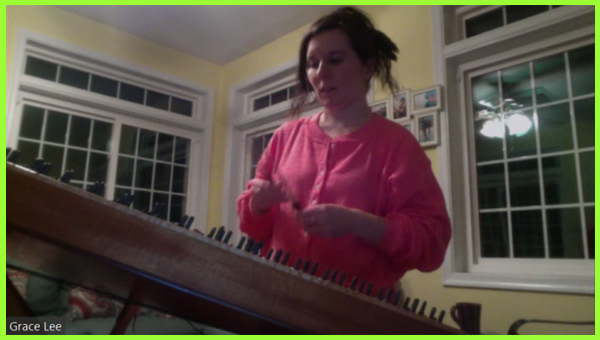
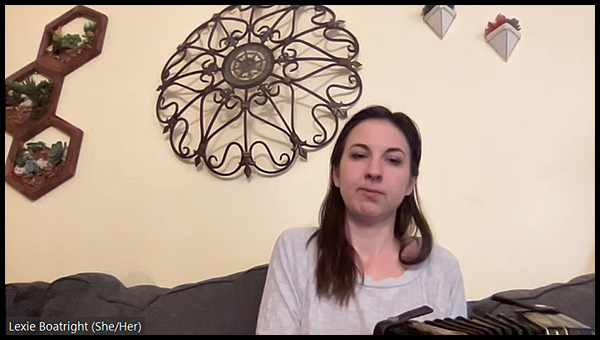
The two share an easy rapport. Lexie is very knowledgeable about Irish music and Grace seems to soak it up. Their comfort with using Zoom was evident, both in their positioning of the camera and, for example, using Zoom’s “original sound” setting so Zoom wouldn’t treat their music as background sound and block it out.
Developing her Irish Voice
Grace is already a competent player on the dulcimer. So she has been learning what makes the tune sound “traditionally Irish” and how to find her own voice on the hammered dulcimer through that tune.
Lexie asked her to play one of the tunes she has been working on this week. Grace played it a couple of times, working on a small correction Lexie offered. Lexie would listen, and perhaps play it back to her on her concertina to demonstrate her point. Grace has the ear to know exactly what Lexie is playing and to be able to mimic her right away.
Lexie explains, “Irish music is about setting an expectation [about where the notes will go] and then building in a ‘twist’.” With that in mind, Lexie began challenging Grace to find some traditional variations to add: an embellishment, a subtle change in the melody, or simply holding a note out long. There are no “right” notes in the traditional aural form of a tune, Lexie observed, but “once we write it down, we give [that set of transcribed notes] weight.”
The Ecosystem of Irish Music
Lexie explains that when playing with other musicians, you have to figure out what your part is in the tune — how to play your instrument in a way that complements the other instruments. In this way, Lexie says, “the tunes can’t be divorced from the session.” In a sense, the session is the ecosystem that supports the music; the context where it grows, adapts, and thrives.
Given Lexie’s emphasis on variation, and her interest in preparing Grace for more active participation in sessions, this suggests that Grace is learning more than the tunes. Grace added that the apprenticeship has pushed her to go to more sessions and increased her confidence in participating. She feels a sense of accountability to bring her music out into the music scene.
Lexie has told Grace, “You have to go to sessions to get the tunes in your ears. ... You don’t need me to teach you a tune. You can go to YouTube for that. But you do need me to help you get the variations, to make it sound Irish, without the influence of your American ears.”
Teaching and Learning Online
Lexie has been teaching online for years. She has students all over the world. Her strategy is to keep it personal and make connections that support the students. She says, “You need to build rapport, to help students feel safe, in order to push them to take risks.”
One thing she likes about teaching online is that the student can mute their microphone and play along as Lexie introduces a new tune. This helps the student get comfortable before playing it back to the instructor — another way to create a sense of safety. She also likes Zoom’s whiteboard feature, which allows her to notate a tune if that feels useful to the student, for them to visually see how the tune progresses.
“Are you paying respect to the culture?”
There is a misperception of Irish music competitions as opportunities to “show off” one’s individual skills and talents. In fact, Lexie says, they are designed to promote a respectful attitude toward the tradition. They encourage you as a participant to listen to and be aware of other players, to honor the aesthetics of the tradition, and to see yourself as part of a larger community. They are a way to “invest in the social future of Irish music.” And Lexie reminds her students to ask themselves if they are paying respect to the culture of Irish music.

Irish Harp, Across the Sea
For harp player Mary-Kate Lee, virtual learning has been essential to her apprenticeship. The master artist she chose to work with, Grainné [GRAH-nya] Hambly, lives in Ireland. The two meet weekly for about an hour, something that would be impossible without the benefit of a video-conferencing platform such Zoom.
Like Lexie, Grainné has been offering classes online for a few years. She likes that she can position the camera in a way that allows her to “see more than [she] can when you are two harps facing each other.” She has a better view of what is going on in the student’s hands, and the student has a better view of small details.
She is adept with her camera, moving it slightly so Mary-Kate can watch her hands more closely, then returning it to a position that brings her face into the screen for conversations and listening. She believes that the opportunity to record both the sound and the visual image really supports a student’s growth.
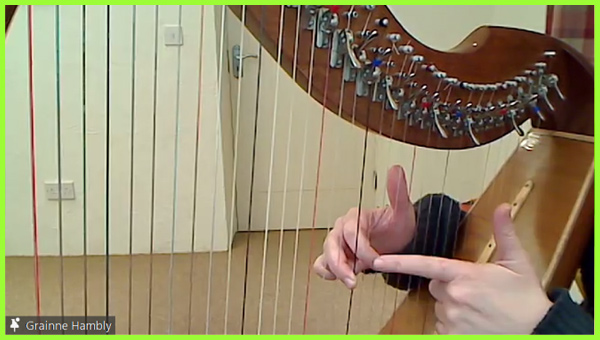
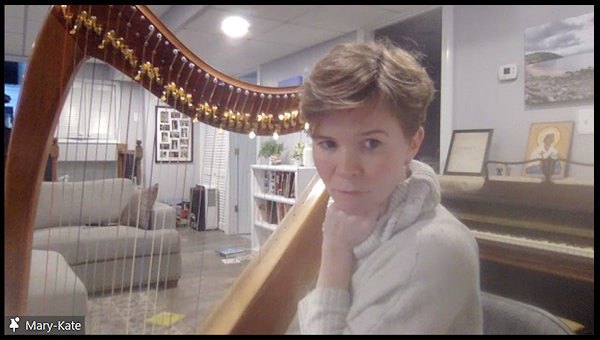
A Balancing Act
The hour began with Mary-Kate playing a lively reel she had been practicing called “Trip to Durrow.” When she finished, Grainné said she really liked her left hand work and her variations. It was clear Mary-Kate had improved since their last meeting; she had more confidence in her notes.
They talked a bit about the balance between the right and left hands. Grainné said, when one hand is busy (lots of notes) the other should be simpler. She invited Mary-Kate to send her an audio recording of her playing it all the way through and she would offer more specific feedback.
The second tune they worked on was a jig. Grainné commented that Mary-Kate’s rhythm had improved a lot and that she really liked the harmonies Mary-Kate had incorporated.
As they worked on various ornamentations, Grainné also cautioned against doing the variations too often. If you do, she said, they are no longer embellishments but part of the tune. And some variations can easily take you off to a different tune — you have to catch yourself before you head off that way. Grainné acknowledged that “if you don’t practice them all the time, they’re never where you want them to be.”
Playing by Ear
Toward the end of the hour, Grainné introduced a new tune: “The Sweetheart Reel.” Before playing it, she offered the provenance, saying she learned it from Mary McNamara and Martin Hayes. She added that she loves the elegance of Mary’s playing; the lack of clutter in the notes.
Grainné played the reel all the way through, all three parts, and then began teaching it to Mary-Kate. This is where Mary-Kate’s competence really shone. She easily picked up the phrasing by ear, even as Grainné was giving her three or four ornamentation options within each part.
When I pointed this out, Grainné said that Mary-Kate has proven to be very talented, moving beyond learning the tunes to finding her own voice in the playing. She clearly has good experience, especially with developing her own left hand arrangements. Because Mary-Kate easily gets up to speed on the tunes, they can focus their work on the subtlety of her arrangements.
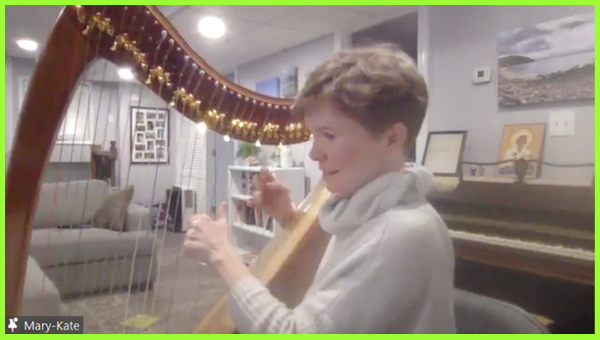

Building a Repertoire
Although one of the goals of this apprenticeship is to build a body of tunes for a recording, Grainné has used the repertoire of Irish music competitions to frame their work. With competitions, there is an expectation of variation: “you might play the tune differently every time you play it, but each time is still your own.”
While variation and ornamentation are important for jigs and reels, they are particularly important for slower, open-ended “airs” — tunes played without a strict meter or melodic structure. Grainné says that a successful competitor must have at least eight good slow airs to demonstrate mastery of traditional Irish musical elements.
Grainné notes that a recording is a transient, singular rendition of the tune, frozen like a photograph. I love this implication that the tune is alive in many versions, and that only through practice do you find your own voice with it.

And the Answer Is...?
Clearly, virtual lessons are working for these two competent and experienced apprentices, eager to improve and develop a personal style.
The two master artists have figured out how to use the technology to share artistic skills as well as the cultural context for the music. Yet, they also acknowledge the importance of face-to-face interactions, whether a music session or a competition, to keep the music “alive” and to truly fine-tune your personal style.
So, while virtual lessons may not supplant in-person, they do give us access to artists we might not otherwise be able to meet, and they nicely complement an apprentice’s broader well-rounded learning experience.



Brand icons for Facebook, YouTube, Instagram and other social media platforms are the trademark of their respective owners. No endorsement is implied.